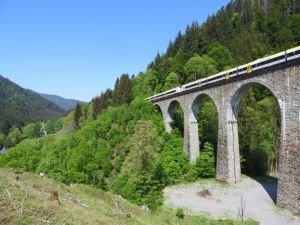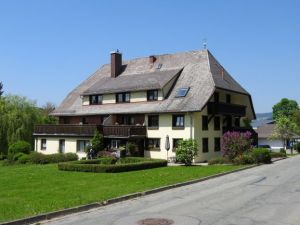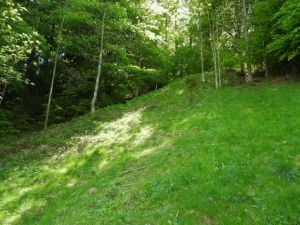Wintersport Feldberg : Différence entre versions
| Ligne 23 : | Ligne 23 : | ||
|Resume_de=Wintersport auf dem Feldberg und touristische Attraktionen entlang der Strasse | |Resume_de=Wintersport auf dem Feldberg und touristische Attraktionen entlang der Strasse | ||
|Resume_en=Winter sports on the Feldberg and touristic attractions along the road. | |Resume_en=Winter sports on the Feldberg and touristic attractions along the road. | ||
| + | |Description_de=TC: 10:00:00:18: | ||
| + | ZT: Weihnachten 1951 / | ||
| + | verschneiter Vorgarten; Fahrtaufnahme (v.E.); Frau steigt aus Auto; Pfarrkirche "Maria Himmelfahrt" in Hinterzarten; Mann vor Haus <vmtl. in Hinterzarten>; Junge u. Mädchen spielen mit Modelleisenbahn (v.E.); Fahrtaufnahme (durch den Schwarzwald), Mann u. Frau steigen aus Auto, Schwenk über Schwarzwaldlandschaft (v.E.); Wintersport: Langlauf, Schild <Gasthof zum Grünen Baum>, Hinweisschild <Zweiglashütten> (v.E.); Autos auf Straße mit Schnee; Gäste in Berghütte, Skifahrer, Verladen der Skier auf Auto (v.E.); Kinder mit Faschingskostümen, Blaskapelle (v.E.); Skispringen in Hinterzarten (v.E.); | ||
|Contexte_et_analyse_de=Der Film beginnt mit einer Gartenaufnahme, die eisüberzogene Pflanzen, Bäume und ein Schild mit der Aufschrift „Weihnachten 1951“ zeigt. Mit ihrem Opel Olympia Caprio fahren die Balkes von Freiburg aus auf der B 31 durch das Dreisamtal nach Himmelreich. Aus dem fahrenden Auto heraus wird links das Gasthaus ‚Himmelreich‘ gefilmt, ein typischer Schwarzwaldhof, der bis heute existiert. Rechts ist eine Kapelle zu erkennen, die später wegen der Verbreitung der Bundesstraße zurückgebaut und links neben dem Gasthaus neu errichtet wurde. Hinter dem Gasthof befindet sich der Bahnhof Himmelreich, an dem sich tal- und bergwärts fahrende Züge der Höllenbahn begegnen. | |Contexte_et_analyse_de=Der Film beginnt mit einer Gartenaufnahme, die eisüberzogene Pflanzen, Bäume und ein Schild mit der Aufschrift „Weihnachten 1951“ zeigt. Mit ihrem Opel Olympia Caprio fahren die Balkes von Freiburg aus auf der B 31 durch das Dreisamtal nach Himmelreich. Aus dem fahrenden Auto heraus wird links das Gasthaus ‚Himmelreich‘ gefilmt, ein typischer Schwarzwaldhof, der bis heute existiert. Rechts ist eine Kapelle zu erkennen, die später wegen der Verbreitung der Bundesstraße zurückgebaut und links neben dem Gasthaus neu errichtet wurde. Hinter dem Gasthof befindet sich der Bahnhof Himmelreich, an dem sich tal- und bergwärts fahrende Züge der Höllenbahn begegnen. | ||
Version du 27 juillet 2020 à 15:40
Résumé
Description
TC: 10:00:00:18:
ZT: Weihnachten 1951 /
verschneiter Vorgarten; Fahrtaufnahme (v.E.); Frau steigt aus Auto; Pfarrkirche "Maria Himmelfahrt" in Hinterzarten; Mann vor Haus <vmtl. in Hinterzarten>; Junge u. Mädchen spielen mit Modelleisenbahn (v.E.); Fahrtaufnahme (durch den Schwarzwald), Mann u. Frau steigen aus Auto, Schwenk über Schwarzwaldlandschaft (v.E.); Wintersport: Langlauf, Schild <Gasthof zum Grünen Baum>, Hinweisschild <Zweiglashütten> (v.E.); Autos auf Straße mit Schnee; Gäste in Berghütte, Skifahrer, Verladen der Skier auf Auto (v.E.); Kinder mit Faschingskostümen, Blaskapelle (v.E.); Skispringen in Hinterzarten (v.E.);
Contexte et analyse
The film begins with a garden shot that shows ice-covered plants, trees and a sign that reads "Christmas 1951". With their Opel Olympia Caprio, the Balkes drive from Freiburg on the B 31 through the Dreisamtal to Himmelreich. The 'Himmelreich' inn is filmed on the left of the moving car, a typical Black Forest courtyard that still exists today. A chapel can be seen on the right, which was later dismantled due to the spread of the main road and rebuilt to the left of the inn. Behind the inn is the Himmelreich train station, where trains going up and down the Höllenbahn meet.
From Himmelreich, the B 31 leads directly to Höllental, which is known for its 'Hirschsprung' at its narrowest point. The viaduct over the Ravenna Gorge is a striking building. Blown up by German troops at the end of the war, the 27-meter-high Ravenna Viaduct was rebuilt under the French occupation after the Second World War. The route of the Höllentalbahn, which leads over the viaduct, is the steepest railway in Germany. It was inaugurated in 1887. The road continues around the Kreuzfelsen to Hinterzarten. The local train station is the starting point for a walk through the town, where the parish church of the Assumption of Mary is recorded. Curt Balke is filmed in front of the Bruggerhaus, which was built in 1627 as a rectory. The following is a short sequence with a Märklin model train layout size H0, which the grandson probably received for Christmas in 1951. Another trip to Breitnau, which is not far from Hinterzarten, is documented. Ms. Balke stands in front of the Löwen inn. From there, the Wirbstein (mountain name) and the Abrahmenhof (right) and Konradenhof (left) are filmed with a view towards Hinterzarten. There was no closed snow cover on this winter excursion.
Skiing in Feldberg, Neuglashütten
On the journey between Titisee and Feldberg-Bärental, the Seebuck and the Feldberg can be seen behind high snowboards. At the beginning of 1952 a lot of snow fell, which according to the weather station there was up to three meters high. In Feldberg-Neuglashütten, Curt Balke skis past the “Grüner Baum” inn, which still exists today. A pan on Neuglashütten follows. Information signs enable a clear geographical orientation. In the subsequent scenes, the Balke family is shown skiing. This is followed by a stop for coffee and cake in a restaurant, probably in the 'Grüner Baum' inn. The following scene, which Ms. Balke shows on skis, was created on the roadside of the B 500 near Neuglashütten. Mr. Balke attached the skis to the car roof. The license plate 'FB-03-4834' indicates the French zone of occupation, 'FB' stood for the country code 'SüdBaden' at the time.
Ski jumping in Hinterzarten In the last section of the film costumed children are shown as well as musicians from a music band at a ski jumping event. Ski jumping took place on the Kirchwaldschanze, a youth ski jump in the Kirchwald von Hinterzarten. This hill was built in 1923 and served as a training hill for young jumpers. It was possible to jump 15 to 30 meters there. It was abandoned in 1973 and the natur takes back the space. Ski jumping events were big events that used to attract many spectators. The new, modern youth ski jump is located next to the large Eagle Jump, on which well-known ski jumping takes place.
Skiing
The first ski tourist on the Feldberg was the French consulate secretary, Dr. R. Pilet in 1889. He was able to inspire many locals to ski. Until the 1950s, skiers only had simple wooden skis that they used for downhill and cross-country skiing. There were no special equipment such as helmets or water-repellent clothing. As a leisure activity, mostly wealthy people went skiing or the boards were used professionally as a means of transportation by postmen, midwives and foresters. In the past, many pupils came to school on skis in Hinterzarten, and there were also ski schools there. The father of the famous ski jumper Georg Thoma was the first certified ski instructor before the Second World War. He gave ski lessons to the guests of the 'Hotel Adler' in Hinterzarten; even private lessons were possible. In 1951 a suspension cable car was built on the Feldberg. 240 people could be transported in one hour. From the early 1970s to the late 1980s, almost every municipality wanted a ski lift in their place. These were also built in St. Märgen, Titisee or Neustadt. Due to climate change, the winters are getting warmer and the amount of snow is smaller. The lifts were dismantled after ten years because the snow line had shifted upwards, which made the lifts unprofitable. Today there are 38 ski lifts and 63 kilometers of slopes in the Feldberg area and snow cannons are used for the slopes. Skiing is only possible in the high areas.
Carolin PonickLieux ou monuments
Bibliographie
- ↑ Cette fiche est en cours de rédaction. À ce titre elle peut être inachevée et contenir des erreurs.








